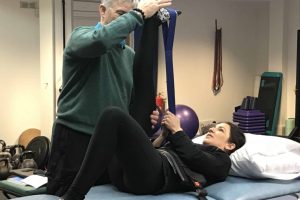Achieving Optimal Health through Osteopathy: A Holistic Approach

Introduction to Osteopathy
What is Osteopathy?
Osteopathy is a holistic approach to healthcare that emphasizes the interrelationship between the body’s systems. Practitioners, known as osteopaths, maintain that the body has a natural ability to heal itself, and their role is to facilitate this process. Using a variety of manual techniques, such as stretching, pressure, and resistance, they seek to improve the body’s structural integrity and promote overall well-being.
- Achieving Optimal Health through Osteopathy: A Holistic Approach
- Introduction to Osteopathy
- What is Osteopathy?
- History of Osteopathy
- Principles of Osteopathy
- Holistic Approach to Health
- Importance of Body's Structural Integrity
- Benefits of Osteopathic Treatment
- Pain Relief
- Improved Mobility and Function
- Conditions Treated by Osteopathy
- Back Pain
- Neck Pain
- Osteopathic Techniques
- Manual Therapy
- Manipulative Techniques
- Osteopathy and Mental Health
- Stress Reduction
- Enhancing Overall Well-being
- Osteopathy for Women's Health
- Pregnancy Care
- Menstrual Disorders
- Osteopathy for Children
- Pediatric Osteopathic Care
- Developmental Support
- Integrating Osteopathy with Other Healthcare Practices
- Complementary Therapies
- Collaborative Patient Care
- Finding a Qualified Osteopath
- Education and Training
- Professional Associations and Certifications
- Key Principles of Osteopathy:
- The body is a unit; the mind, body, and spirit are interconnected.
- The body is capable of self-regulation and healing.
- Structure and function are interrelated; dysfunction in one can affect the other.
History of Osteopathy
The origins of osteopathy trace back to the late 19th century, founded by Dr. Andrew Taylor Still in 1874. Disillusioned by the limitations of conventional medicine, Still developed this discipline, advocating for a more comprehensive understanding of the body.
- Milestones in Osteopathy’s Evolution:
- 1892: The founding of the first osteopathic school, still emphasizing a hands-on approach.
- 1917: The establishment of the American Osteopathic Association, marking the formal recognition of the profession.
As the decades progressed, osteopathy gained worldwide acceptance, integrating with various healthcare systems while retaining its core principles of holistic treatment and patient care.
Principles of Osteopathy
Holistic Approach to Health
At the core of osteopathy is a holistic approach to health, which means looking at the whole person rather than just treating isolated symptoms. Osteopaths believe that mental, emotional, and physical health are interconnected. This perspective allows for a more comprehensive understanding of each patient’s unique health journey. For example, if a patient presents with chronic headaches, an osteopath might explore lifestyle factors like stress, sleep, and nutrition. They would not only focus on relieving the pain but also aim to address the underlying causes, leading to lasting health benefits.
- Benefits of a Holistic Approach:
- Promoting self-awareness and empowerment in patients.
- Enhancing the body’s natural ability to heal through balanced treatments.
- Fostering a meaningful patient-practitioner relationship.
Importance of Body’s Structural Integrity
Another essential principle of osteopathy is the importance of the body’s structural integrity. Osteopaths emphasize that misalignments or restrictions in the body’s structure can lead to functional issues and various health problems.
- Key Concepts:
- Proper alignment of joints and muscles facilitates optimal function.
- A well-aligned body supports effective circulation, nerve function, and overall health.
- Treating structural dysfunctions can provide relief from pain and discomfort.
By maintaining or restoring structural integrity, osteopathy advocates for healthier living, where the body can operate efficiently and adapt gracefully to life’s stresses and challenges.
Benefits of Osteopathic Treatment
Pain Relief
One of the most significant benefits of osteopathic treatment is pain relief. Many patients seek osteopathy for conditions like back pain, joint discomfort, or chronic headaches. Through various manual techniques, osteopaths are able to alleviate pain by addressing its root causes rather than just masking the symptoms.
- Techniques for Pain Relief:
- Soft tissue manipulation to relax tight muscles.
- Joint mobilization to improve movement and reduce stiffness.
- Gentle stretching to promote better circulation and flexibility.
Patients often report faster recovery times and a reduction in reliance on pain medications, helping them to reclaim their daily activities with less discomfort.
Improved Mobility and Function
Osteopathic treatment also significantly enhances mobility and overall function. Many patients notice improved range of motion, allowing them to engage in activities they previously found challenging.
- Benefits of Improved Mobility:
- Increased flexibility leads to better athletic performance.
- Enhanced joint function reduces the risk of injury.
- Greater ease of movement improves daily productivity.
For individuals limited by pain or stiffness, this newfound freedom can transform daily life, making activities from exercise to simple chores more enjoyable and manageable. By focusing on holistic care, osteopathy empowers patients to move more freely and live life to the fullest.
Conditions Treated by Osteopathy
Back Pain
Back pain is one of the most common conditions treated by osteopaths, and it’s a complaint many individuals face at some point in their lives. Whether caused by poor posture, sports injuries, or chronic stress, osteopathic treatment offers targeted relief. Osteopaths assess the entire body, not just the area of pain. They employ gentle manipulation techniques aimed at restoring balance and alignment, helping to ease pain and enhance mobility.
- Benefits of Treating Back Pain:
- Reduction in tension and muscle tightness.
- Improved spinal alignment.
- Enhanced mobility, allowing patients to return to everyday activities.
Many patients report significant improvement within a few sessions, often transitioning from pain to comfort.
Neck Pain
Neck pain is another prevalent issue that osteopaths effectively address. Whether due to prolonged computer use, stress, or accidents, neck pain can limit daily activities and affect overall quality of life. Osteopathy focuses on restoring balance to the spine and surrounding tissues, alleviating pressure and improving blood flow.
- Common Techniques for Neck Pain Relief:
- Gentle cranial and cervical movements to relieve stiffness.
- Soft tissue massage to alleviate muscle tension.
- Ergonomic advice for better posture during daily activities.
Patients frequently find that their neck pain decreases significantly, allowing for greater comfort during work, sleep, and relaxation. By treating the whole person, rather than just the symptoms, osteopathy enables long-lasting relief and enhanced well-being.
Osteopathic Techniques
Manual Therapy
Manual therapy is a cornerstone of osteopathic treatment, focusing on the hands-on techniques that promote healing and relieve discomfort. Osteopaths harness their in-depth knowledge of anatomy to assess and treat various conditions effectively. Patients often find this approach incredibly soothing. For instance, through gentle manipulation, osteopaths can ease tension in tight muscles or improve circulation in affected areas.
- Benefits of Manual Therapy:
- Reduction of pain and muscle tightness.
- Enhanced tissue flexibility and elasticity.
- Promotion of relaxation and overall well-being.
Many individuals leave their sessions feeling not only physically improved but also mentally refreshed, a testament to the holistic nature of osteopathy.
Manipulative Techniques
Building on manual therapy, manipulative techniques are central to osteopathy, focusing on specific adjustments to the body’s structure. These techniques aim to restore proper function, relieve pain, and improve mobility. Examples include:
- Osteopathic Manipulative Treatment (OMT): Involves precise movements to realign joints and relieve pressure.
- High-velocity low-amplitude thrusts: Quick, controlled movements aimed at restoring motion to restricted joints.
Patients often experience immediate improvement in their range of motion and a reduction in pain following these interventions. The combination of manual and manipulative techniques not only aids in recovery but also empowers individuals to take charge of their health, paving the way for a more active, fulfilling life.
Osteopathy and Mental Health
Stress Reduction
Osteopathy is not just about physical health; it also plays a vital role in mental well-being, particularly in stress reduction. Many patients experience high levels of stress due to fast-paced lifestyles, work pressures, or personal challenges. Osteopaths use gentle manipulative techniques to release muscle tension, which can lead to a significant decrease in stress and anxiety levels.
- Ways Osteopathy Helps With Stress:
- Improves blood circulation, which helps flush out stress hormones.
- Promotes relaxation through targeted muscle release and body alignment.
- Encourages mindfulness and body awareness during treatment.
Patients often leave their sessions feeling lighter and more centered, enabling them to tackle daily challenges with improved resilience.
Enhancing Overall Well-being
Beyond stress reduction, osteopathy significantly enhances overall well-being. By addressing both the physical and emotional aspects of health, osteopaths create a holistic therapy environment that fosters healing. For example, individuals often experience:
- Improved Sleep Quality: Alleviating physical discomfort leads to better sleep, which is crucial for mental health.
- Increased Energy Levels: With less pain and tension, patients often report feeling more energized and motivated.
- Greater Emotional Stability: A balanced body can contribute to a more settled mind, allowing for improved emotional responses.
Through this comprehensive approach, osteopathy not only alleviates symptoms but also promotes a healthier mindset, empowering patients to engage fully in life.
Osteopathy for Women’s Health
Pregnancy Care
Osteopathy offers invaluable support during pregnancy, a time when a woman’s body undergoes significant changes. Expectant mothers often experience discomfort due to weight gain, postural changes, and hormonal shifts. Osteopaths are trained to provide gentle, safe treatments tailored specifically for pregnant individuals to alleviate pain and discomfort.
- Benefits of Osteopathic Treatment During Pregnancy:
- Reduces lower back pain and pelvic discomfort.
- Enhances mobility, making daily activities easier.
- Improves posture and supports the body’s changing alignment.
Many women report feeling more comfortable and relaxed after their sessions, allowing them to embrace the joys of pregnancy with greater ease.
Menstrual Disorders
Osteopathy also addresses various menstrual disorders, including dysmenorrhea (painful periods), irregular cycles, and premenstrual syndrome (PMS). By focusing on the pelvic area, osteopaths aim to alleviate discomfort and improve reproductive health.
- How Osteopathy Helps:
- Releases pelvic tension to ease pain and cramping.
- Enhances circulation, promoting hormonal balance.
- Provides emotional support through a holistic approach.
Patients frequently find that regular osteopathic treatments lead to less menstrual discomfort and a better understanding of their bodies, contributing to overall well-being. By addressing both physical and emotional aspects, osteopathy empowers women to navigate their health journey with confidence.
Osteopathy for Children
Pediatric Osteopathic Care
Osteopathy is not just beneficial for adults; it offers a wide range of advantages for children as well. Pediatric osteopathic care addresses various childhood issues, from colic and feeding difficulties to postural concerns and sports injuries. Osteopaths use gentle, non-invasive techniques tailored specifically for children, creating a comfortable and supportive environment.
- Key Benefits of Pediatric Osteopathic Care:
- Alleviates discomfort from conditions like colic or reflux in infants.
- Supports proper alignment and posture during growth spurts.
- Enhances overall well-being, promoting better sleep and mood.
Parents often report significant improvements in their child’s comfort and behavior following osteopathic treatments, leading to happier, healthier little ones.
Developmental Support
Osteopathy plays a crucial role in supporting children’s development during critical growth phases. From helping with motor skills to addressing behavioral concerns, osteopaths can provide invaluable guidance.
- Ways Osteopathy Supports Development:
- Encourages healthy movement patterns, aiding gross and fine motor skills.
- Provides strategies for managing stress and anxiety in children.
- Facilitates coordination and balance during physical activities.
Parents frequently notice that their children become more confident and active, thanks to the comprehensive approach of osteopathic care. By investing in a child’s health during formative years, osteopathy lays the foundation for a lifetime of well-being and resilience.
Integrating Osteopathy with Other Healthcare Practices
Complementary Therapies
Integrating osteopathy with complementary therapies can offer a more holistic approach to health and wellness. Many patients find that treatments such as acupuncture, physiotherapy, or massage therapy work synergistically with osteopathy, enhancing overall results. These therapies address different aspects of health, creating a comprehensive treatment plan.
- Benefits of Combining Therapies:
- Addresses both physical and emotional well-being.
- Facilitates faster recovery and pain relief through coordinated care.
- Provides a wider range of options tailored to individual patient needs.
For example, a patient with chronic back pain may benefit from osteopathic manipulation combined with massage therapy, resulting in decreased discomfort and improved mobility.
Collaborative Patient Care
Another integral aspect of integrating osteopathy with other healthcare practices is the emphasis on collaborative patient care. Osteopaths often work alongside other healthcare professionals, including general practitioners, chiropractors, and nutritionists, to ensure comprehensive treatment for their patients.
- Key Benefits of Collaborative Care:
- Enhanced communication between healthcare providers leads to more informed decisions.
- Tailored treatment plans addressing all facets of a patient’s health.
- Improved patient outcomes through shared expertise and resources.
Patients notice a significantly more personalized and effective approach to their care when all practitioners collaborate, paving the way for holistic health that meets their unique needs. By considering the body as a whole, integrated care systems empower patients on their wellness journeys, leading to sustainable health improvements.
Finding a Qualified Osteopath
Education and Training
Choosing a qualified osteopath ensures that you receive high-quality care tailored to your individual needs. A reputable osteopath typically undergoes extensive education and training, often earning a degree in osteopathy or equivalent healthcare fields. This education encompasses both theoretical knowledge and practical application, enabling them to understand the intricacies of the human body.
- What to Look For:
- A Bachelor’s degree in a related field, followed by a Master’s or advanced osteopathic degree.
- Completed internships or clinical placements to gain hands-on experience.
- Ongoing professional development and specialized training in areas relevant to your needs.
Feeling confident about your healthcare provider’s qualifications can significantly enhance your treatment experience.
Professional Associations and Certifications
When searching for a qualified osteopath, checking their membership in professional associations can provide additional assurance of their credibility. Associations like the American Osteopathic Association or the National Osteopathic College can serve as reliable benchmarks.
- Benefits of Professional Associations:
- Membership indicates adherence to specific ethical and professional standards.
- Access to continued education and resources keeps practitioners informed about the latest advancements in osteopathy.
- Certification from recognized bodies often qualifies practitioners for advanced scopes of practice.
By ensuring that your osteopath is well-educated and affiliated with professional organizations, you can feel confident in their ability to provide effective, evidence-based care for your health and wellness journey.





